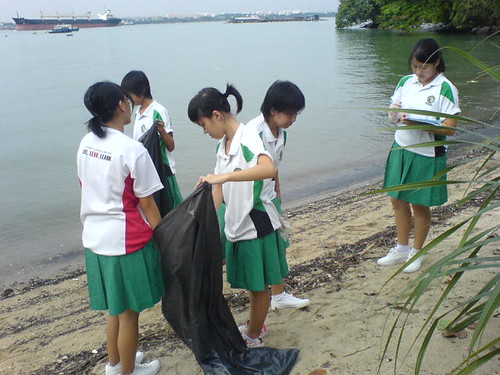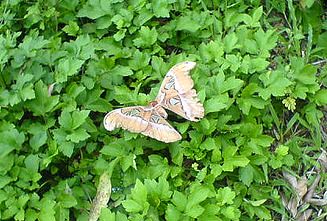Although the buses were late and we (Grace, Danliang and I) were frantically counting the seconds of beach lost to the high tide, the entire group still managed some clean up part of the beach. If somewhat on a minor scale. Nevertheless, the students, interns, guides, teachers and parent volunteers spanned the coastline with enthusiasm that surprised me.
Recalling back to the times when I had to do community involvement programs (C.I.P) back in secondary school, there was always an air of grouch clouding over. I guess collecting donations on Orchard road has absolutely no way to compare with the thrill of going away from mainland. Even if it's just cleaning up the coastline. Anyway, these lucky kids get much more out of the trip away from mainland by being exposed to one of the reclusive yet still-surviving islands of Singapore.

After the rubbish collected were fished out, collated and weighed, they were given a mini lesson on the different molluscs and shells that are found naturally on the beach. Earlier on, they caught a jelly fish and examined it before letting it go. Some were fascinated over a tiny crab. So I guess them knowing that the molluscs and shells found on the beach are actually the "chutchut" and "gong gong" they eat must have been really interesting.

After that, it was time to explore the Sensory trail. It's termed "Sensory" because it caters to our five senses. The blind would be able to feel the guiding ropes and move along, smell the pandan leaves, hear the crickets humming, even read braille on signposts. These considerate acts just emphasizes how often we need to put ourselves in others' shoes to make the world a better living place for everyone. A little altruistic, but that's one way to achieving utopia isn't it?

Back to the sensory trail, we were enthralled by our guide, uncle Ah Hock, as he introduced the history along with the flora and fauna found there. Malay, Chinese and Indian heritage back in the good old days were revealed by him. Some students gamely went back in time by chewing the leaves old coolies used to freshen themselves up. Plants which oozes poisonous sap, and blind people should it get in the eyes when the leaves break were also demonstrated. We were then enlightened on the many proliferating plants that provided so many basic medical needs for the residents. It was like having everything in your backyard. You just needed to know which plant works for which symptoms of illnesses which really makes me respect them. Their knowledge and experience must be extremely vast.
With the flora flourishing, how can anyone miss the fauna bit? Tracks of a wild boar's foraging path were scouted followed by the elusive and beautiful golden web spider on her delicate golden web. We also had the honor of viewing the Atlas moth which is the largest moth in the world up close while it was in its dying throes as we were told.

Soon, it was time leave for mainland. Everyone had mosquito bites wherever skin was exposed. Yet I'm sure they had fun. One acknowledgement goes out to the person in charge of this trip; Grace who amazed and taught everyone with her bountiful knowledge. It was really easy to get hurt while clearing up the beaches but her repeated concise briefing spared the group from any such thing. Also, her sincerity extended throughout the entire trip, which is really inspiring as reality often don't see people working alongside such passion.
All in all, a good trip which brings back the message that Singapore isn't a land barren with heritage. In fact, discoveries like Chek Jawa speaks volumes that there could be more out there, unknown and waiting to be discovered by us. The guide was right in saying that the younger generation should be educated in Singapore's history, culture and biodiversity to give them reason to fight and protect whatever remaining heritage left; just as it was with Chek Jawa. That would just be the tip of the iceberg and the future of preserving such wondrous places will thus lie with passionate Singaporeans of the future generations.

No comments:
Post a Comment